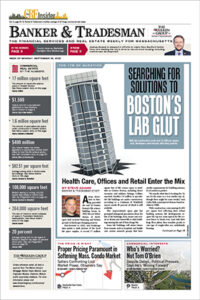Jamie Kelliher
Principal, Axiom Architects
Industry experience: 10 years
Unlike many architects, Jamie Kelliher started his career in the building trades, first as a framer and a cabinetmaker before branching into other finishing trades.
Kelliher is the second person in his family to help lead Hanover-based Axiom Architects, a firm his father James Kelliher founded over 40 years ago. His own career started with an internship for the visionary architect Paolo Soleri in Arizona, but eight years ago he traded sunny desert skies for the Bay State when he took a job at a mid-sized firm in the Springfield area.
Q: How did you get into this line of work?
A: I grew up watching my father design and draft buildings, and I loved exploring local construction sites to see how buildings went together. After earning a bachelor’s degree in architecture, I was immediately attracted to a more “hands-on” side of the building industry. After a brief stint in wood and metal framing, I committed to working as a cabinetmaker for several years. I then branched into other finishing trades including interior trim/woodwork, flooring and finished concrete.
All of these experiences gave me great background experience as I moved into the field of architecture. I still love working with my hands and stay connected by renovating my historic home on the South Shore.
Q: Your firm started with mostly design residential work, but now is getting into mixed-use and restoration work. Why did you make this move?
A: Going back to my days as a student, I have always had a great interest in both areas, so it was exciting to see some opportunities of this nature come along after I joined Axiom. I had gained a solid amount of experience in managing larger projects in my previous firm, so that helped us to transition into accepting some of these larger contracts for mixed-use buildings in our local area.
As for the historic restoration/adaptation work, Axiom has gained quite a lot of experience through the years working on older homes, so this was a natural transition for us. Both of these avenues have allowed our company to stay active and relevant in a residential design market that has become very saturated and competitive.
Q: What are the challenges with doing restoration work instead of just tearing down a home and building new?
A: Massachusetts is home to many privately owned historic buildings that are not subjected to strict local restrictions limiting what can be changed or removed. We hate seeing any historic buildings taken down, but unfortunately that is a reality today in an industry where often the cost to restore and remodel an older building far outweighs the cost of a new building. Accessibility requirements have certainly contributed to that elevated cost, and so our firm has become well versed in retrofitting historic buildings for accessibility.
The public view is often quite different from the view of a building owner who is faced with the reality of making the costs work. For this reason, restoration work often requires additional funding from state or local sources that can help to offset the added cost. We will always encourage owners to make every effort to keep buildings that offer historical significance, but we are also realistic with our clients about cost and value.
Q: Why is mixed-use so important right now and how can it help communities with high rent and other housing issues?
A: In recent years the need for new housing in many Massachusetts communities has been widely discussed at the state level. Mixed-use development, which typically incorporates first–level commercial space with apartments or housing on the upper levels, is an alternative opportunity to provide the needed housing in zones that may have previously only included ground–floor commercial activities. There are abundant opportunities for redeveloping failing suburban strip–mall-style properties to include residential uses in a creative way that could potentially result in a more pleasant, walkable community environment. This approach could also, over time, help to preserve residentially zoned areas from being subjected to larger multi-story housing complexes that residents often strongly oppose.
Q: Is there anything in the future you hope to incorporate in your mixed-use projects?
A: We are seeing more and more requests to explore mixed-use design projects in smaller suburban towns, especially in our local South Shore area. Towns have begun to encourage small– and medium–sized mixed-use projects as a way to improve village districts or existing commercial areas, and to start to build walkable communities. Many of the districts that allow this type of development are close to commuter rail transportation, eliminating the requirement of owning a car.
Our firm is working hard to show that the architectural design of this relatively new suburban building typology can be easily adapted to fit the smaller scale, more traditional aesthetic of these towns. We are looking to break away from the form of a typical “urban style” mixed-use building and seamlessly integrate our projects into their unique and often historically rooted environments.
Kelliher’s Five Favorite Things:
- Any design by Carlo Scarpa
- Mid-century furniture
- Making things with wood
- Vintage 1980’s skateboards
- Traveling in Europe






